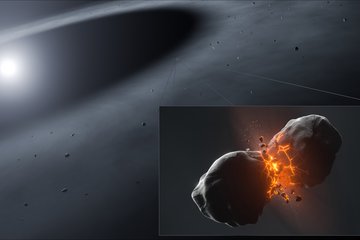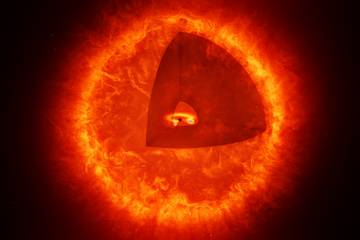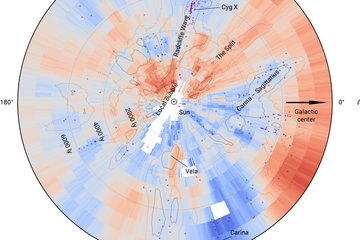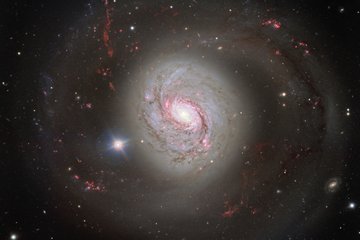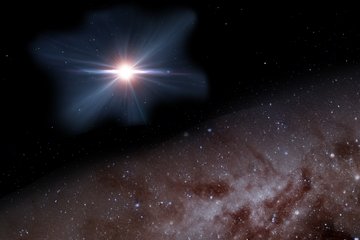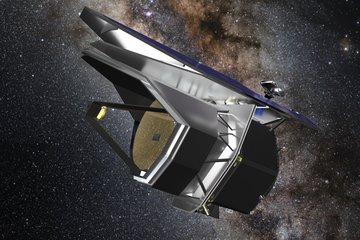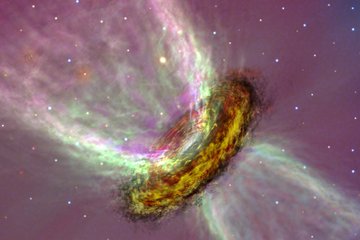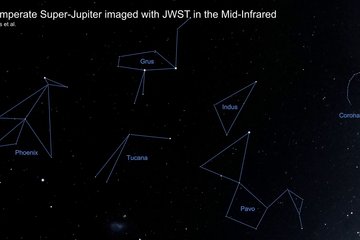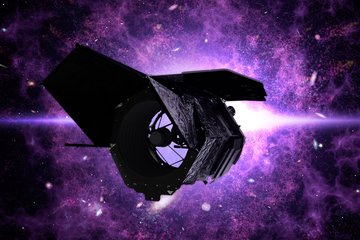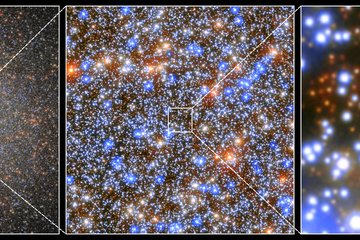The dance of massive stellar couples
Astronomers find evidence for stars of young massive binary systems to approach one another within the first million years after birth.
Most massive stars occur in close pairs in which both stars orbit the common centre of mass. However, we do not yet know how such binary star systems form. A group of astronomers led by Dr María Claudia Ramírez-Tannus from the Max Planck Institute for Astronomy in Heidelberg, Germany, have now found evidence that massive stars form in wide orbits that shrink rapidly, and both stars approach each other after birth. The researchers inferred this from a shift in the velocity spread of the massive stars to larger values the older the star cluster becomes. They attribute this effect to a reduction in the stellar orbital radii of massive binaries.

Stars usually form in clusters within clouds of gas and dust. A relatively small proportion of them have masses of more than eight times that of the Sun and are therefore considered massive. For still unknown reasons, they often form binary star systems with small separations between the individual stars. A group of astronomers led by Dr María Claudia Ramírez-Tannus from the Max Planck Institute for Astronomy (MPIA) in Heidelberg have now discovered that the velocity dispersion of massive stars increases rapidly with the age of the clusters they belong to. The team attributes the effect to the increase in the orbital speeds of the massive binaries as the stars gradually converge and their orbits shrink.
For ideal situations, this effect is known as the conservation of angular momentum. The law states that a rotation speed increases when mass moves to the centre of the circular motion. We see this, for example, during the pirouettes of figure skaters, who bring their arms to the body for faster rotation. Although stellar binaries do not fully comply with this law, the analogy is still correct in qualitative terms.
In recent years, the research group have observed several young star formation regions. They measured the speed of individual massive stars and determined their luminosity and surface temperature. To do this, they used various spectrographs mounted on the Very Large Telescope (VLT) of the European Southern Observatory (ESO) in the Chilean Atacama Desert. Like a prism, these instruments split light into its colour components, which physicists call a spectrum. The spectrographs capture the spectral lines of chemical elements in the stellar atmospheres and notice even the smallest wavelength shifts. Using this ability, the research team have now derived the speeds at which the stars move along the line of sight, the so-called radial velocity. They also supplemented their data set with previously published results. When the astronomers combined all these velocities, they obtained the massive stars’ velocity dispersion, a statistical measure of the spread of radial velocities.
“Our results suggest that massive binary stars initially form on large orbits and within little time develop into close binary systems,” explains Ramírez-Tannus. “This is an important finding that helps to narrow down the models of formation mechanisms.” Indeed, massive double stars in older star clusters tend to have close orbits with orbital periods of between a few days and weeks.
To understand what causes stars to move closer together, scientists propose two scenarios. Stars form from dense condensations within large clouds of gas and dust. During the star formation process, rotation causes this condensation to flatten into a disk, while the star emerges at the centre. If massive binary stars already form as pairs, their orbits pervade the residual disk. Friction with the disk material causes the orbits to shrink and the orbital speed increases.
The second mechanism occurs in systems with a third, lower-mass star. Its gravitational force diverts the more massive companions into elliptical orbits that over time approach smaller and circular trajectories. The reduced orbital radii again lead to higher velocities. In some cases, the lower-mass star is ejected from the system.
The random movement of stars in a cluster results in a narrow range of speeds, which leads to a dispersion of only a few kilometres per second. However, if there are enough close massive binary stars in the cluster, their fast orbital speeds shift the dispersion to higher values.
Measuring stellar luminosities and surface temperatures from the spectra establishes the connection to the age of the clusters. Depending on their mass, stars have a characteristic combination of luminosity and temperature, which changes with age. Hence, by measuring the stellar properties of the stars, astronomers can determine the age of clusters.

By combining the results, the scientists around Ramírez-Tannus found a correlation between the velocity dispersion of massive stars in clusters and their age, suggesting that the dispersion increases rapidly within a few million years. The astronomers conclude that the orbital velocities of the binaries increase, which indicates the orbits becoming correspondingly smaller.
However, the velocity dispersions only provide a restricted view of the processes that occur inside the individual binary systems. Therefore, co-author Frank Backs of the University of Amsterdam has employed simulations to extract information on the orbital periods of binary stars that are consistent with the measured velocity dispersions.
“I simulated many clusters by varying the orbital period distribution of their binary systems. This way, I managed to compute which of them would result in the observed velocity dispersions,” Backs explains. He adds, “many simulations are required because we do not know the systems’ exact properties such as their orientation, which impact the observed dispersions.“
Overall, the study has shown a clear trend in which the smallest orbital periods decrease from months to a few days within about 1.6 million years. “Despite the partially large uncertainties of the individual measurements, the trend is clear,” Ramírez-Tannus notes. “Although the time scale determined is not yet very accurate, we can conclude that by astronomical standards, the orbits of massive binary stars shrink rapidly.”
Background information
Scientists from the Max Planck Institute for Astronomy (MPIA) in Heidelberg, the Anton Pannekoek Astronomical Institute of the University of Amsterdam, the Netherlands, the Astronomical Institute of the KU Leuven, Belgium, as well as from the Department of Astronomy at Stockholm University, Sweden, were involved in this research project. In addition to María Claudia Ramírez-Tannus, other MPIA collaborators were Henrik Beuther, Wolfgang Brandner, Hendrik Linz and Thomas Henning.
MN


